Dealing with winter damage in lavender
Learn about winter damage in lavender, how to prune, and average winter survival rates for cultivars.
The winter of 2013/2014 was one of the coldest in the last two decades in southern Ontario. Damage to lavender is significant, especially on the lavandins (Lavandula x intermedia). On-going cultivar and row cover trials in lavender can be used to identify methods to reduce winter damage in the future. This article will provide some highlights of the results of these two trials. A full report of these trials will be available on the Ontario Lavender Association website within a month. The trials were funded through an OMAFRA New Directions grant through the Ontario Lavender Association and are a collaborative effort between OMAFRA, the University of Guelph and the Ontario Lavender Association.
The damage and how to prune
Figure 1 shows typical damage to a Lavandula angustifolia (English lavender) cultivar 'Royal Purple'. Often the branches at the top are dead but the branches around the perimeter of the plant are alive, possibly related to the location of snow cover during the coldest periods (Figure 2). Most angustifolia cultivars are capable of sending up new shoots from the base as shown in Figure 3. Any tissue showing no signs of life at this time are likely dead. Removing these branches may improve the appearance of the plant and allow more light to reach the new shoots growing from the base, but the new growth will likely hide the dead tissue within a few weeks. Leaving the plants unpruned is a viable option for those with large acreages and limited labour.
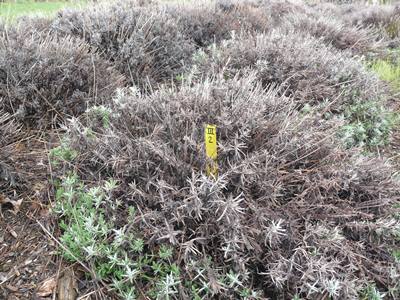
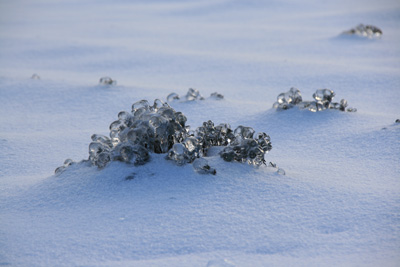
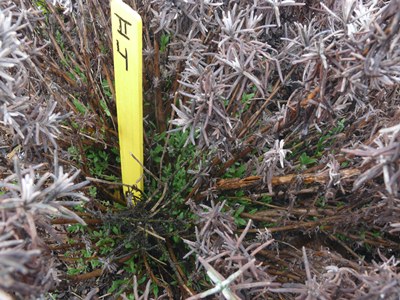
Lavandins are in much worse shape in many locations with often only a branch or two at the bottom of the plant showing any signs of life (Figure 4). Younger lavandins are able to respond with new shoots from the base, although the new growth is not as vigorous as in the angustifolias. Older lavandins have much less capacity to sprout new growth. A few of these plants are developing very small new buds near the base of branches that are otherwise dead, but it is unknown if these will be sufficient to keep the plants alive. For those plants with only a few branches showing any signs of life, it is unknown if these will provide sufficient energy to the plant to allow for new growth. The only option with these plants is to remove the dead tissue and wait for new shoots. If no new shoots develop, then the plant will likely need to be replaced. If new shoots do develop, the existing live branches should be kept on for a month or two until the new growth is vigorous and then they can be removed to restore a rounded plant shape. Observations on how plants respond to the winter injury will be taken over the next few weeks to provide better guidance on pruning techniques for this type of damage in the future.
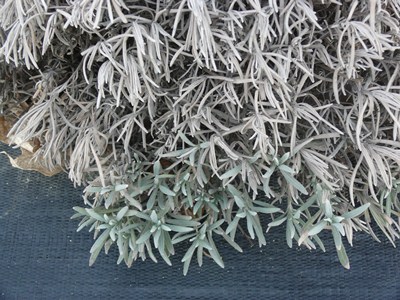
The amount of damage depends on the location. Areas with deep snow cover over the winter have much less damage than areas where there was limited snow cover or frequent freeze and thaw cycles. However, the ice storm that occurred in December may have caused considerable damage even in areas with good snow cover, depending on the depth of snow at the time.
Cultivar trial results
Cultivar trials are in place at six sites in southern Ontario in Essex, Elgin, Norfolk and York counties. Damage varied depending on the site with the least damage at York due to good snow cover and the most damage in Norfolk and Elgin counties. The trials are evaluating 27 cultivars including both angustifolia and lavandin types. The cultivars with the highest ratings for each year are shown in Table 1. For all four years of the trial, the angustifolia 'Folgate' had the least damage of all cultivars. Several additional angustifolias have consistently high ratings including 'Royal Purple', 'Royal Velvet', 'French Fields', 'Dark Supreme' and 'Imperial Gem'. The pink-flowered cultivar 'Melissa' had good ratings for three years but poor ratings after the winter of 2013/2014. 'Folgate' had an average winter survival rating of 4.3 out of 10 (0 = dead, 10 = healthy), showing how significant the damage was across all cultivars. The highest rating for a lavandin was 2.0 out of 10 for 'Impress Purple', which is an unacceptable level of damage. 'Impress Purple' plants were younger than the other cultivars, which may account for its improved hardiness this past winter.
| Rank | 2010/2011 | 2011/2012 | 2012/2013 | 2013/2014 |
|---|---|---|---|---|
| #1 | Folgate | Folgate | Folgate | Folgate |
| #2 | Betty's Blue | Royal Velvet | Dark Supreme | Royal Purple |
| #3 | French Fields | Royal Purple/Melissa | Imperial Gem | Royal Velvet |
| Rank | 2010/2011 | 2011/2012 | 2012/2013 | 2013/2014 |
|---|---|---|---|---|
| #1 | Fat Spike Grosso | Fat Spike Grosso | Grosso | Impress Purple |
| #2 | Edelweiss | Grosso | Super | Edelweiss |
| #3 | Hidcote Giant | Edelweiss | Fat Spike Grosso/Edelweiss/Gros Bleu | Gros Bleu |
The results of the study show that all lavandins require some level of protection to get through a colder than normal winter. In addition, some lavandins are not recommended for production in Ontario even with protection unless the grower is able to withstand losing the plants every few years. Lavandins not recommended for production in Ontario include 'Provence', 'Alba', 'Tuscan Blue' and 'Fred Boutin'. Many angustifolias will survive harsh winters without protection, but with considerable damage in cold winters. These may benefit from winter protection to ensure consistent and heavy bloom. Based on four years of results, 'Folgate' is the top cultivar for winter survival and is the least likely to be damaged over winter without a row cover.
Row cover trial results
A research trial was established at the University of Guelph, Simcoe Research Station in 2013 (Figure 5). The lavandin cultivars 'Grosso' and 'Provence' were evaluated in the trial as a marginally hardy and not hardy cultivar in Ontario, respectively. The lavender was either uncovered over the winter or covered with straw, thin white row cover (Agryl P-40) or thick white cover (Hibertex Pro). Results are presented in Table 2. The survival of 'Grosso' lavender was significantly improved under both row covers. Straw resulted in complete plant death across the entire trial for both cultivars and is not recommended for winter protection. The lavender in this trial was grown over black plastic mulch, and the combination of plastic and straw may have contributed to plant death. No 'Provence' plants survived uncovered, and row covers did not improve survival significantly. This suggests that some cultivars should not be grown under any circumstance on a large scale. Three on-farm row cover trials were established in 2012 on either 'Hidcote' or 'Grosso' lavender and have gone through two winters. Both row covers improved survival in the winter of 2012/2013 at all three locations. However, in 2013/2014 there were no significant differences between row cover treatments and the uncovered control. All three sites had deep and consistent snow cover from December through March at it is likely that deep snow cover protected the plants and reduced the impact of the row covers.
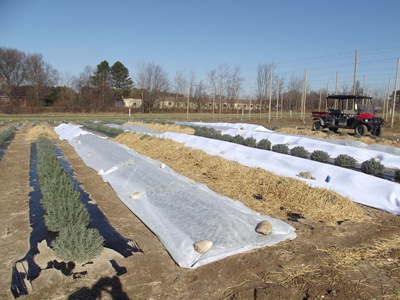
| Row Cover Treatment | Winter Survival Rating Grosso | Winter Survival Rating Provence |
|---|---|---|
| None | 3.4 b | 0.0 a |
| Straw | 0.0 a | 0.0 a |
| Thin Cover (Agryl P40) | 6.6 c | 0.4 ab |
| Thick Cover (Hibertex Pro) | 5.4 c | 0.5 b |
The results of the row cover trials suggest that row covers are a good option to reduce damage to sensitive cultivars such as most of the lavandins and a few angustifolias. Without cover, these cultivars will likely have considerable damage in some winters. In four trial locations and two years for three of them, row covers have reduced winter damage in four of seven cases and did not harm the lavender in any of them. They did not provide benefits when there was consistent snow cover over the whole winter, which is very rare in most of southern Ontario. It is still unknown how the row covers will work in a mild winter or what protection they provide to older plants. Research will continue for at least another year.
To reduce damage in the future growers should choose cultivars that have survived the winter well in all four years of our trial. At this point, 'Folgate' is a good option based on winter survival. Including several hardier cultivars will reduce the risk of complete crop loss. Many growers rely on lavandins for sachets, dried bundles and essential oil production. Lavandins do not appear to be fully hardy in southern Ontario, and benefit from protection over the winter. Row covers appear to be a good option to reduce damage, but growers need to do an economic analysis of the costs of the row cover vs the loss of plants over the winter. If cost is an issue, consider protecting enough plants for core products and agri-tourism activities. It should also be kept in mind that winter kill can occur due to other factors including disease, ice around the crown of the plant and flooding, and row covers will not help to reduce the effects of any of these issues.
Footnotes
- footnote[1] Back to paragraph Scale of 0 to 10: 0 = dead; 1 = 1 - 10% healthy; 2 = 11 - 20% healthy… 10 = 91-100% healthy.
- footnote[2] Back to paragraph Numbers in a column followed by the same letter are not significantly different at P=0.05, Fisher's Protected LSD Test.